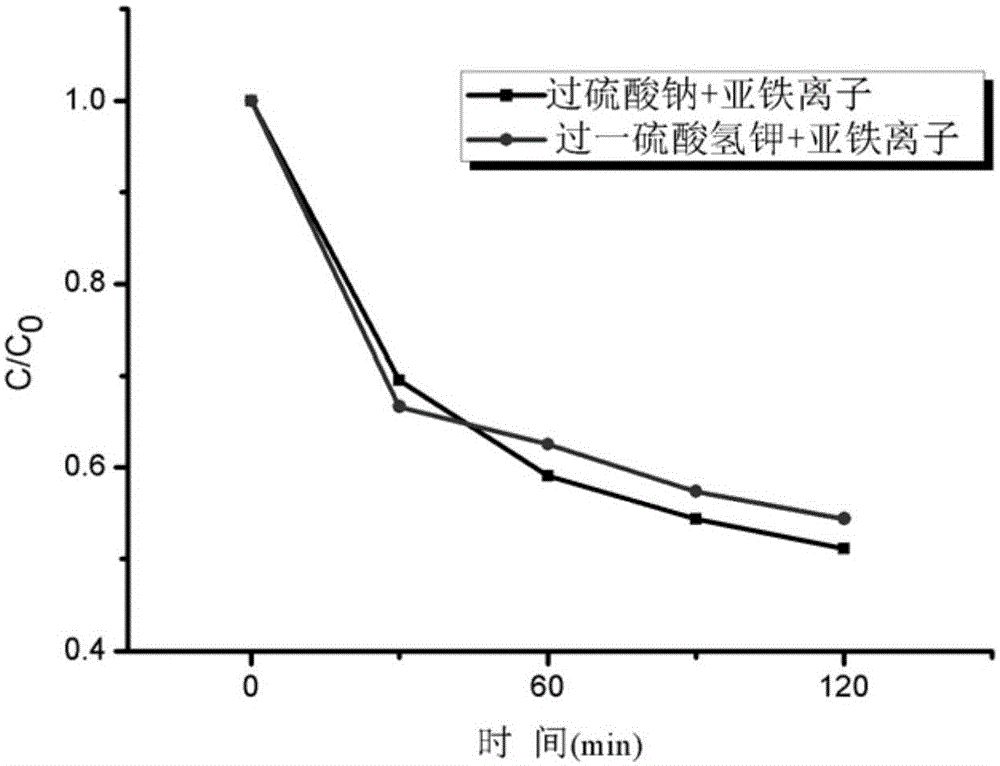Method for degrading smelly substance in water through oxidizing agent activated by ferrous iron
A technology of smelling substances and oxidants, which is applied in the field of water treatment technology to achieve good degradation effects, easy storage, transportation and use, and easy promotion and application
- Summary
- Abstract
- Description
- Claims
- Application Information
AI Technical Summary
Problems solved by technology
Method used
Image
Examples
Embodiment 1
[0030] (1) Take 7 headspace vials containing 3gNaCl and 0.2mL of 2-isobutyl-3-methoxypyrazine (IBMP) with a concentration of 10ng / L, and prepare the concentrations as 10, 20, 50, 100, 200 , 500, 1000ng / L of 2-MIB or GSM, and measure with gas chromatography-mass spectrometer (GC-MS: GasChromatography-MassSpectrometer), make a standard curve, such as figure 1 as shown, figure 1 The standard curve for measuring 2-MIB prepared by the internal standard method for the embodiment of the present invention, the internal standard substance is 2-isobutyl-3-methoxypyrazine (IBMP). The abscissa is A 2-MIB / A IBMP , represents the ratio of the peak area measured by the substance in gas chromatography-mass spectrometer (GC-MS: GasChromatography-MassSpectrometer), and its ordinate represents the concentration of the prepared 2-MIB, and its measured data trend The fitting equation of the line is y=1378.6x-16.077, where the linear coefficient is R 2 =0.9991, which can meet the measurement n...
Embodiment 2
[0038] On the basis of the method in Example 1, the concentration of 2-MIB or GSM is 1000ng / L, the concentration of sodium persulfate and ferrous sulfate heptahydrate is 0.5mM, react at normal temperature, and the reaction time is 120min. The pH of the reaction was measured with a concentration of 1 x 10 -3 mol / L of hydrochloric acid or sodium hydroxide, adjust the pH of the solution to experiment under the conditions of 3, 7, and 8. The experimental results are shown in Table 2.
[0039] Table 2
[0040] pH value
[0041] This embodiment utilizes ferrous ions to activate persulfates (sodium persulfate, potassium hydrogen persulfate, etc.) to degrade the refractory odor and taste substances (2-MIB, GSM) etc. in water bodies under different pH conditions. Under neutral and acidic conditions, it can effectively reduce the smell in water and purify water quality. Compared with Fenton oxidation method, ozone oxidation method, wet oxidation method and other methods, thi...
Embodiment 3
[0043]On the basis of the method in Example 1, the concentration of 2-MIB or GSM was 1000ng / L, pH=7, and the reaction was carried out at normal temperature, and the reaction time was 120min. The molar ratio of the concentration of sodium persulfate to ferrous sulfate heptahydrate was 1:1, and the experiments were carried out under the conditions of 0.1mM, 0.5mM, 1mM and 1.5mM respectively, and the degradation effects were measured respectively. The measurement results are shown in Table 3.
[0044] table 3
[0045] Concentration of sodium persulfate (mM)
[0046] In this example, ferrous ions are used to activate different concentrations of persulfates (sodium persulfate, potassium hydrogen persulfate, etc.) to degrade odorous substances (2-MIB, GSM) that are difficult to degrade in water bodies, and the degradation effect can be seen slightly increased with increasing persulfate concentration.
PUM
| Property | Measurement | Unit |
|---|---|---|
| concentration | aaaaa | aaaaa |
Abstract
Description
Claims
Application Information
 Login to View More
Login to View More - R&D
- Intellectual Property
- Life Sciences
- Materials
- Tech Scout
- Unparalleled Data Quality
- Higher Quality Content
- 60% Fewer Hallucinations
Browse by: Latest US Patents, China's latest patents, Technical Efficacy Thesaurus, Application Domain, Technology Topic, Popular Technical Reports.
© 2025 PatSnap. All rights reserved.Legal|Privacy policy|Modern Slavery Act Transparency Statement|Sitemap|About US| Contact US: help@patsnap.com


